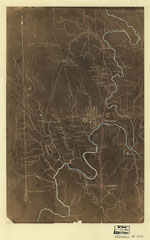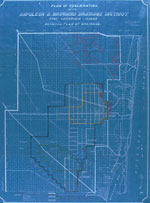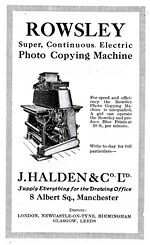Blueprints
Much neglected by historians, this early photographic process played an important role in the wider dissemination of maps and plans
By Jeffrey S. Murray Jeffrey Murray is a former senior archivist with Library and Archives Canada, Ottawa, Canada, and author of Terra Nostra: The Stories Behind Canada’s Maps, 1550-1950 (Montreal: McGill-Queen’s University Press, 2006).
“Employees of the public works department will complete today one of the largest blueprint orders ever attempted by the city,” announced The Times to its readers in St. Petersburg, Florida. In what was heralded as a technological marvel, the 1927 article went on to explain that the order amounted to eight copies of a 591-sheet plan of the city’s sewer system. Using one of the new Pease blueprinters that incorporated the print, wash, and dry cycles into a single machine, the large-format plans were processed onto forty-two-inch wide paper at the rate of fifty yards every thirty minutes. But best of all, the 4,728 sheets had cost the city a modest $150, or about thirty-two cents a piece. For St. Petersburg the blueprint had ushered in a new era. Now, for the first time in the city’s history, the superintendent and all the foremen working on the city’s new south-side sanitary system would have access to drawings on site. There would be no need to run back to city hall and consult originals in the engineer’s office.
The reproduction of large-format, hand-drawn maps and plans onto light-sensitive paper is almost as old as the first experiments in photography itself. During the American Civil War, the Union Army set up a mobile printing office that used a procedure developed by Captain William C. Margedant. The printing was done by drawing the required map onto tracing paper and laying it over a sheet of paper coated with silver nitrate. Placing the two papers in a box that allowed the sun’s rays to pass through the original map blackened the treated paper except under the inked lines, leaving white markings on a black background. The chemicals used in the process, however, were expensive, and map distribution had to be limited to company commanders only.
The Philadelphia Centennial Exposition of 1876 introduced the far more cost-efficient blueprint to America. It used paper pre-washed on one side with a mixture of ferric ammonium citrate and potassium ferricyanide to make it light sensitive. Exposing the treated paper to the sun’s ultraviolet light turned the ferric salts to an insoluble Prussian blue in areas not obscured by lines in the original drawing. In other words, the master document acted as a photographic negative, and the resultant blueprint was a contact print or facsimile that had the same scale as the original drawing, but the image was a negative (white lines on a blue background).
Unlike Captain Margedant’s method, blueprints had no emulsion – the light-sensitive iron salts are infused into the paper fibres. Since the chemicals were readily available locally and could be easily mixed and applied to almost any good quality paper, blueprinting quickly supplanted Captain Margedant’s method and dominated large-format photocopying for nearly a century.
Sun printing was, of course, highly dependent on the weather. If bright sunlight was available, the exposure time would be from thirty to forty-five minutes and up to ninety minutes in cloudy weather. For sun printing, it was possible, with a small outlay, to make a homemade frame that held the master document firmly in contact with the printing paper. A felt backing and a heavy plate-glass cover ensured that the original document and blueprint paper were in firm, even contact. Any unevenness between the two sheets would result in fuzzy lines on the blueprint. In the early decades of the twentieth century, commercially made wooden frames could be purchased for about $20.
The introduction of electrical lighting in the early 1900s meant the blueprint industry was no longer dependent on sunlight and that the entire process (print, wash, and dry) could be incorporated into a single, continuously running machine like the Pease blueprinter used in St. Petersburg. Most blueprinting machines operated on the same principles. They featured a wooden or metal drum around which the original drawing and sensitized paper moved together under pressure and exposure to a high-intensity light source. The exposed paper was then separated from the original document and passed through a water bath, followed by an electrical drier. The blueprint paper was kept on a roll at the front of the machine and could be cut to any length.












